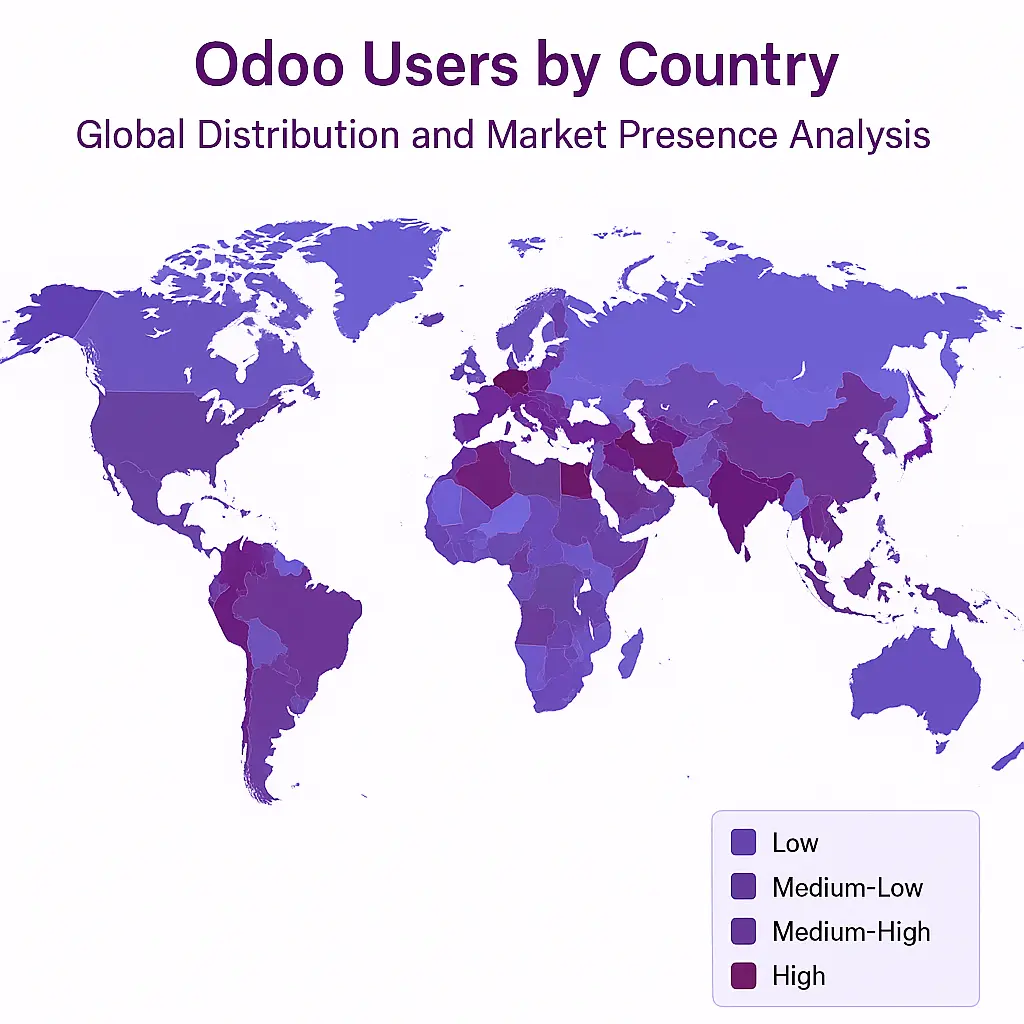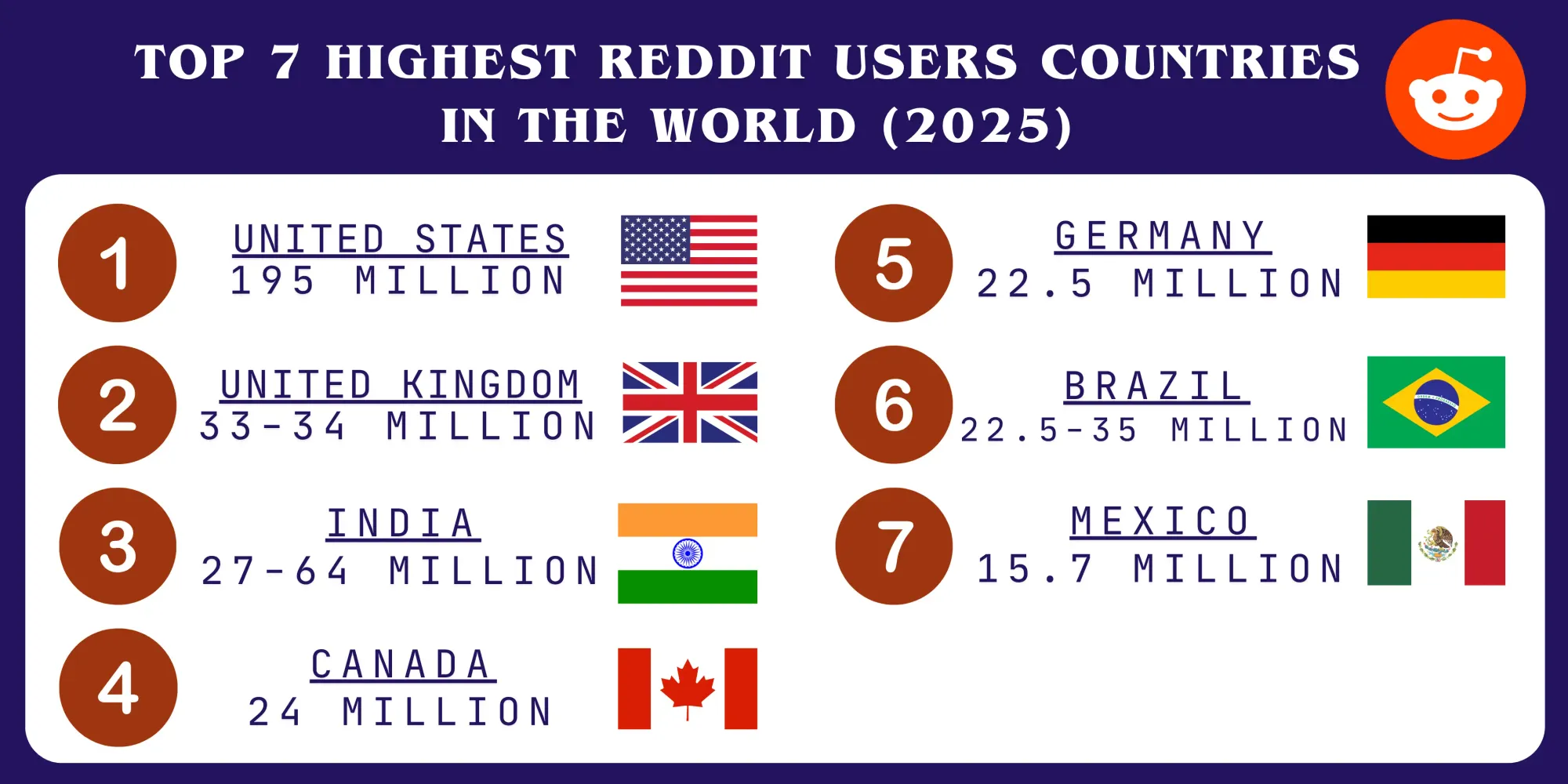Odoo is amongst the most utilized business software solutions across the globe, as more than 11 million community edition users and over 1.4 million enterprise edition users in 175 countries favor Odoo. It is listed as one of the most installed business software programs French-speaking users worldwide, with a large number of users emerging from small and medium-scale enterprises. As a global ERP and CRM suite, it’s important to understand its geographical distribution. 13,000,000 users worldwide, from startups to big companies. Deloitte awarded Odoo for its fast growth, 1,549% in 5 years. Odoo, having a very high company valuation depicting its exponential growth and industry recognition, is considered as one of the fastest-growing companies. Odoo, introduced by Fabien Pinckaers, in 2005, with a clear vision, has helped in shaping the company’s life, potential growth, and trajectory via innovation and key achievements.
The geographic distribution of Odoo users reveals interesting facts about regional business habits, economic development, and the evolving ERP market. Companies all over the world use Odoo’s flexible and modular business apps to fit their business needs, from Belgium to Africa and Asia. Odoo offers a complete suite of integrated business tools, including a CMS, forms, and performance management tools, making it a powerful and intuitive platform for diverse business needs.
Odoo's on-premise and cloud options have contributed to its widespread adoption as installed business software, making it a reliable choice for businesses seeking flexibility in deployment premises.
This article will lookat where Odoo users are globally, what drives adoption in each region, and how local factors impact implementation in each country and industry. Odoo updates 50 main apps every 2 months, so the platform stays relevant and efficient for all business needs. New versions are released regularly, and version management is a key aspect of Odoo's product development. And thousands of community apps to adapt to specific business requirements.
Top Countries Using Odoo Worldwide

The US leads the world in Odoo adoption with 60,679 live websites using the platform. That’s 26.45% of all Odoo users worldwide and a strong presence in North America. The top 3 countries for Odoo users are the US, Belgium and France.
Belgium, where the company was founded by Fabien Pinckaers, comes in second with 1,398 customers, 13.08% of the global user base. This large odoo market share is not only due to the company’s Belgian roots but also the local partner ecosystem and deep integration with European business practices.
France is close behind with 1,368 customers, 12.80% of Odoo’s global presence. The proximity to Belgium and language support have contributed to strong adoption in French-speaking regions, especially in services and consulting.
| Country | Number of Odoo Customers | Odoo Market Share | Key Industries |
|---|---|---|---|
| United States | 60,679 | 26.45% | Retail, E-commerce, Services |
| Belgium | 1,398 | 13.08% | Services, Manufacturing |
| France | 1,368 | 12.80% | Services, Consulting |
| Germany | ~1,200 | ~11.22% | Manufacturing, Industrial |
| India | ~800 | ~7.48% | Technology, Startups |
Germany is another major European market, where companies in the manufacturing and industrial sectors use Odoo’s project management and production modules to match their size and complexity.
India is Odoo’s largest Asian market, driven by the rapid digitization of small and medium enterprises. The country’s growing tech sector and startup ecosystem have adopted Odoo’s flexibility and cost-effectiveness, making it the fastest-growing region for Odoo. Odoo has modules for customer relationship management, e-commerce, billing, accounting, manufacturing, warehouse management, project management, and inventory management. Odoo’s architecture enables many freelancers and companies to develop and sell Odoo Apps, contributing to its widespread adoption and customization.
The Netherlands and the UK complete the top European markets, with strong adoption in retail, e-commerce, and service industries. Companies in these countries benefit from Odoo’s comprehensive suite of business applications and its scalability for growing businesses.
Regional Distribution Patterns
Europe has the highest concentration of Odoo users by country, thanks to the platform’s origins and deep localization efforts across the continent. The regional distribution reflects historical development patterns and ongoing market trends that favour open-source ERP solutions. The Odoo Community Association, created in 2013, supports the collaborative development of Odoo features and strengthens the ecosystem and innovation.
European Dominance
Belgium, France, Germany, the Netherlands, and the UK account for most of the European Odoo implementations. Several factors contribute to this concentration: proximity to the Odoo team, extensive partner network, EU regulations and cultural acceptance of open-source software.
The European market shows mature adoption patterns with a mix of Community and Enterprise deployments. Companies across various industries use Odoo as part of their core business, from accounting and the to full management systems.
North American Growth
The US leads North American adoption, followed by steady growth in Canada. American companies, especially in retail and e-commerce, see Odoo as an alternative to traditional ERP systems like SAP. The platform’s user-friendly interface and flexible pricing models appeal to companies that want to avoid the complexity and cost of legacy enterprise software.
Asia-Pacific Expansion
India is the fastest growing region for Odoo adoption since 2020, driven by digital transformation initiatives and the rise of technology startups. Australia and Southeast Asian countries show similar growth patterns with local partners playing a key role in market penetration.
The Asia-Pacific region prefers Community edition deployments, due to cost and technical capabilities of local development teams. However, Enterprise adoption grows as companies scale and need advanced features and live support on YouTube and other channels.
Emerging Markets
Latin America concentrates adoption in Mexico, Brazil and Argentina where economic modernization and government digitization initiatives create demand for flexible ERP solutions. These markets show how Odoo’s open-source model fits the budget constraints while delivering full business functionality.
Middle East and African markets, including South Africa, Nigeria and the UAE, are emerging opportunities. These regions benefit from Odoo’s Community edition and the growing ecosystem of local implementation partners.
ecosystems
Several factors explain why some countries have higher Odoo adoption rates and how local conditions influence the implementation approach in different markets.
Odoo, being from Belgium, gives us a natural advantage in the European market. Our headquarters provides direct access to the leadership, an extensive partner network and a deep understanding of European business needs. This proximity means faster feature development, better localisation, and a stronger support network across the continent. We raised $90M in 2019 to fuel our growth and development.
European Union compliance features make Odoo very attractive to EU-based businesses. We natively support GDPR, European accounting standards, and multi-currency for cross border commerce. This built-in compliance reduces implementation complexity and ongoing maintenance costs. We license our Community edition under the GNU LGPLv3 so businesses can access and adapt.
Odoo supports over 40 languages so you can go global while staying local. Countries with complex regulatory environments benefit from dedicated localization modules for local accounting standards, tax calculations,, and payroll systems.
The strength and expertise of local Odoo partners has a big impact on regional adoption rates. Countries with established partner ecosystems have higher implementation success rates and customer satisfaction. These partners provide services like system customization, employee training, and ongoing support that determine long-term adoption success. We have over 1500 active members contributing to the applications, so our ecosystem is growing.
Odoo’s modular pricing and scalability fit perfectly with markets dominated by small and medium enterprises. Countries with strong SME sectors, especially in technology and services, show high adoption rates. The platform can grow with your company, so it’s attractive for businesses that want to expand. We transitioned to an open core model so we provide both subscription-based enterprise software and open source versions to cater to different business needs.
Open-Source Cultural Acceptance
Regional attitude towards open-source software has a big impact on adoption rates. Countries with a strong technology community and government support for open-source solutions have higher Odoo penetration. This is why we see different adoption rates between otherwise similar markets.
Industry Adoption by Country
Different countries have different industry preferences for Odoo implementation, depending on local economy, business practices a and sector requirements.
German companies, especially in manufacturing and industry, have, some of the most advanced Odoo implementations. They use the full suite of modules, including inventory management, production planning, and quality control. The platform is flexible enough to adapt to complex manufacturing processes and keep everything integrated across departments. Odoo has 6.34% market share in the Performance Management category, so it’s relevant for industry specific needs.
German manufacturers like Odoo’s project management and multi-location capabilities. The platform can handle from small specialized manufacturers to large industrial companies that need full ERP functionality.
Retail and E-commerce in US and UK
US and UK companies lead the way in retail and e-commerce adoption, using Odoo’s all-in-one platform to manage online sales, inventory and customer relationships. They often combine CRM, project management and accounting modules to create a full business management system. Odoo’s competitors in the Performance Management category are Cornerstone OnDemand, Personio HR Software and CIVICHR, so we operate in a competitive landscape.
The e-commerce integration is particularly interesting for companies that have both online and physical retail channels. Live support on YouTube and extensive documentation help you optimize your implementation for maximum performance.
Service Sector in France and Belgium
French and Belgian companies are strong in professional services, consulting, and creative industries. They use Odoo for project management, time tracking, and client relationship management. The platform is flexible and can be customized for service delivery workflows while keeping financial oversight.
Service companies love Odoo because it integrates customer communications, project timelines, and billing processes in one system. This reduces administrative overhead and improves client service delivery.
Technology and Startups in India
Indian technology companies and startups choose Odoo as a cost-effective alternative to traditional enterprise software. They often start with the Community edition and migrate to Enterprise as they grow. The platform is modular, so you can add functionality as your business evolves. Odoo won 3 consecutive BOSSIE Awards from 2014 to 2016 for open-source software innovation.
Startups like Odoo’s rapid deployment and minimal initial investment. The growing ecosystem of Indian partners provides local expertise while keeping costs lower than international alternatives.
Market Growth Trends by Region
Regional growth patterns show how different markets adopt Odoo and what drives growth in various geographic areas.
Asia-Pacific: Fastest Growth Since 2020
Asia-Pacific has seen the most growth in Odoo adoption since 2020, driven by the pandemic’s accelerated digital transformation. India, Australia, and several Southeast Asian markets are growing at double-digit rates as companies look for cloud-based business applications.
This growth mirrors broader economic trends of increased technology adoption, growing entrepreneurship, and government support for digitization initiatives. The region’s preference for cost-effective solutions aligns perfectly with Odoo’s value proposition.
Europe: Steady Growth
European markets show steady, sustainable growth patterns of mature technology adoption. Companies in these markets often migrate from legacy systems or expand existing Odoo implementations to additional business units or geographic locations.
The European growth pattern is depth over breadth; companies implement comprehensive solutions that integrate multiple business functions. This creates higher per-customer value and stronger long-term relationships.
Latin America: Digital Transformation
Latin American adoption accelerated during the global shift to remote work as companies looked for integrated platforms to manage distributed operations. Government digitization incentives and economic modernization programs have created a favorable environment for ERP adoption.
These markets are interested in cloud-based deployments, reflecting infrastructure considerations and the need for flexible, scalable solutions that can adapt to changing economic conditions.
Africa: Emerging Market
African markets are a growth opportunity as more SMEs look to digitize to be competitive and compliant. The open source model is particularly attractive to budget-conscious organizations and provides the functionality for business growth.
Local partner development and increasing internet infrastructure is creating a favorable environment for continued growth across the continent.
Local Implementation Characteristics
Implementation approaches vary greatly across countries and regions depending on local business practices, technical capabilities and economic conditions.
Community vs Enterprise Edition Preferences
Developing markets and price-sensitive SMEs often choose the Community edition for the first implementation, taking advantage of the open source model to minimize upfront costs. These organizations have internal technical teams that can manage system administration and basic customization.
Developed economies have higher Enterprise edition adoption rates, and they value integrated support, advanced features, and cloud deployment options. They prioritize reduced implementation risk and ongoing vendor support over initial cost savings.
Customization and Localization Requirements
Countries with complex regulatory environments require extensive customization for local compliance. This includes specialized accounting modules, tax calculation systems and integration with government reporting requirements. This customization need drives the growth of local Odoo service providers and creates opportunities for specialized partners.
Government and Educational Sector Growth
European Union countries see growing government sector adoption as public organizations look for cost effective, customizable ERP solutions that comply with procurement and data privacy requirements. Educational institutions worldwide implement Odoo for administration, finance, and student management, leveraging open source for budget sensitive operations.
Partner Ecosystem Development
The availability and quality of local implementation partners has a big impact on adoption. Countries with strong partner ecosystems have higher customer satisfaction and retention rates. These partners provide essential services like system setup, employee training and ongoing technical support that determines implementation success.
Industry Specific Adaptations
Countries have different levels of industry specific customization depending on local business practices and regulatory requirements. Manufacturing heavy regions develop production modules, service oriented economies focus on CRM and project management enhancements.
Conclusion
The global distribution of Odoo users by country shows a platform that can adapt to different market conditions while keeping its core value proposition of flexibility, affordability, and full functionality. From the US's massive adoption to Belgium’s early adopter market, each region has its pattern that reflects local business needs and economic conditions.
The data shows clear regional strengths: Europe’s mature compliance focused implementations; North America’s retail and e-commerce; Asia-Pacific’s technology sectors growth; and emerging markets implementing digitization solutions. This is valuable information for companies considering implementing Odoo and for the broader ERP market.
As Odoo expands its global presence, the platform is showing to adapting to local
Frequently Asked Questions
Is Odoo widely used in the United States?
Yes, over 60,000 active Odoo customers in the United States use Odoo, making it very popular among American businesses.
In how many countries is Odoo utilized?
Odoo serves businesses in approximately 175 countries worldwide, reflecting its extensive global reach.
What is the total number of Odoo users?
More than 13 million users worldwide use Odoo, spanning both the Community and Enterprise editions.
Who typically uses the Odoo ERP system?
A diverse range of companies, from startups to large enterprises across various industries, including retail, manufacturing, technology, and services, use Odoo.
Which organizations are among the largest customers of Odoo?
Large enterprises and multinational companies across sectors such as manufacturing, retail, and services rank among Odoo’s biggest customers.
In which regions is Odoo predominantly used?
Businesses predominantly use Odoo in North America, Europe (especially Belgium, France, Germany), Asia (notably India), Latin America, and emerging markets in Africa and the Middle East.
What is Odoo’s market share in the ERP sector?
Odoo holds a significant market share, including around 6.34% in the Performance Management category, positioning it as one of the leading ERP providers globally.
Which ERP system currently has the highest Odoo market share?
Other major players like SAP, Oracle, and Microsoft Dynamics hold the largest shares of the ERP market, although Odoo ranks among the top ERP systems.
Are large corporations using Odoo?
Many large companies use Odoo because of its scalability, modular design, and comprehensive applications.
Who are Odoo’s main competitors?
Cornerstone OnDemand, Personio HR Software, CIVICHR, SAP, Oracle, and Microsoft Dynamics compete directly with Odoo.
What income can Odoo partners expect?
Odoo partners typically generate revenue through implementation, customization, and support services, with earnings varying widely based on services offered and market.
What are some drawbacks of using Odoo?
Users may face challenges such as the need for technical expertise for customization, potential costs for enterprise features, and varying support quality depending on the partner.
What is the difference between location and warehouse in Odoo?
Odoo defines a warehouse as a physical or logical storage site, while a location specifies a particular place within a warehouse to organize inventory.
What types of users exist in Odoo?
Odoo supports various user roles such as administrators, managers, salespeople, accountants, and warehouse staff, each with tailored access permissions.
How large are the companies that use Odoo?
Companies of all sizes, from single-user startups to enterprises with hundreds of thousands of users, use Odoo.
Who should consider using Odoo?
Businesses seeking a flexible, scalable, and integrated suite of business applications, from SMEs to large corporations, should consider Odoo.
What is the typical cost of implementing Odoo?
Implementation costs vary based on company size, customization needs, and whether businesses choose the Community or Enterprise edition.
Where is Odoo headquartered?
Odoo’s headquarters are in Belgium.
Are there open-source ERP options available?
Yes, Odoo Community Edition is open source, and other open-source ERP solutions also exist.
Who primarily uses ERP systems?
Businesses of all sizes primarily use ERP systems to integrate core processes such as finance, supply chain, manufacturing, and customer relations.
Are free ERP solutions available?
Yes, free ERP options such as Odoo Community edition and other open-source platforms are available.
How can one find ERP customers?
Industry research, business networks, and market analyses help identify ERP customers, typically companies seeking integrated business software.
Which ERP system is most widely used globally?
SAP, Oracle, Microsoft Dynamics, and Odoo rank among the most widely used ERP platforms worldwide.
What is the most commonly used ERP system?
SAP often ranks as the most commonly used ERP system globally, while Odoo gains rapid adoption, especially among SMEs.
What are the three main ERP systems?
SAP, Oracle, and Microsoft Dynamics often represent the leading ERP systems.
Who is the largest ERP provider?
SAP generally holds the position as the largest ERP vendor by market share.
How many users does Odoo have?
Over 13 million users worldwide use Odoo.
Why has Odoo gained popularity?
Users appreciate Odoo’s modular design, open-source roots, affordability, scalability, and extensive community support.
Which country owns Odoo?
Belgium owns and hosts Odoo’s headquarters.
Is Odoo a Chinese company?
No, Belgium owns Odoo; it is not a Chinese company.
How large is Odoo as a company?
Odoo employs thousands of people and serves millions of users globally, making it a significant player in the ERP market.
What types of companies use Odoo?
Companies ranging from startups to large enterprises across industries such as manufacturing, retail, services, and technology use Odoo.
What is the typical size of Odoo customers?
Odoo customers range widely in size, from small businesses with a handful of users to large enterprises with hundreds of thousands of employees.
Which countries use ERP systems extensively?
Countries including the United States, Europe, China, and India extensively use ERP systems.
How large is the global ERP market?
Industry analysts value the global ERP market in the tens of billions of dollars, and it continues to grow steadily.
How many companies use ERP software worldwide?
Millions of companies worldwide use ERP software to manage their operations.
Who is the leading ERP vendor?
SAP leads the ERP vendor market globally, with strong competition from Oracle, Microsoft, and Odoo.
What distinguishes Odoo Community from Odoo Enterprise?
The Community edition is open source and free, while the Enterprise edition offers additional proprietary features, services, and support.
Is Odoo Enterprise worth the investment?
Companies needing advanced features, dedicated support, and cloud deployment find significant value in the Enterprise edition.
How can one upgrade from Odoo Community to Enterprise?
Businesses upgrade by purchasing an Enterprise subscription and migrating data and customizations, often with partner assistance.
What functions does Odoo provide?
Odoo offers a comprehensive suite of business applications, including CRM, ERP, accounting, inventory, project management, e-commerce, and more, all integrated into a single platform.













